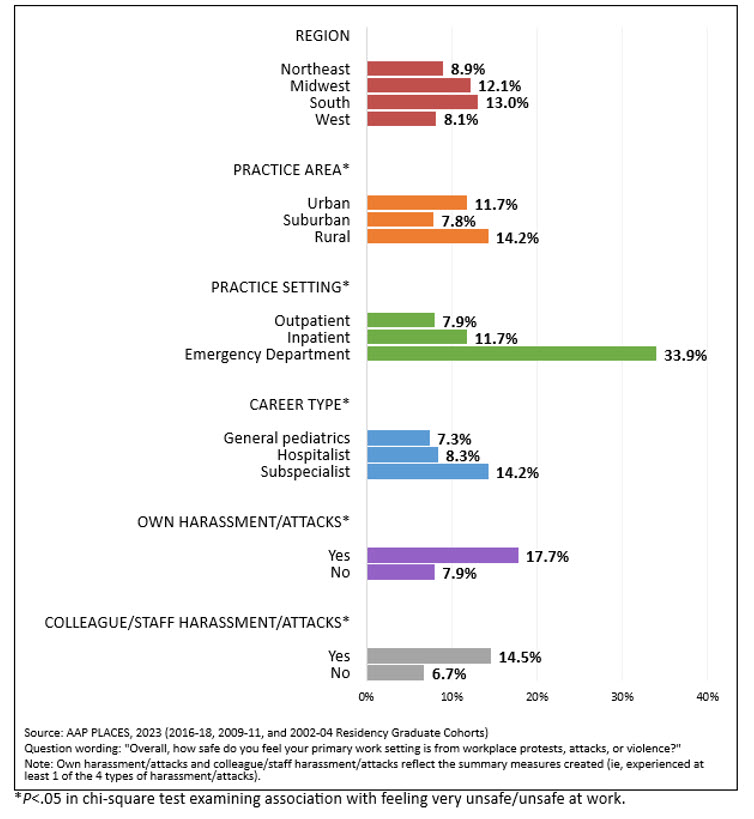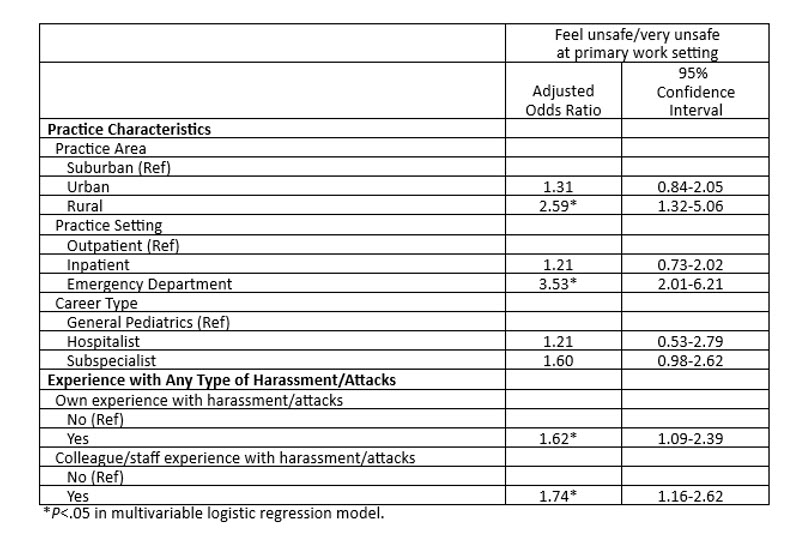Gottschlich E, Byrne B, Frintner M,
Presented at the 2024 Pediatric Academic Societies Annual Meeting
Background: Violence towards health care workers has been reported in recent years. National data on harassment and attacks on pediatricians are lacking.
Objective: Examine experiences with harassment and attacks and perceptions of workplace safety in US pediatric practice. Identify associations of feeling unsafe at work with practice characteristics and experiences with harassment and attacks.
Methods: National weighted survey data from the AAP Pediatrician Life and Career Experience Study (PLACES), a longitudinal cohort study. 41% of randomly selected pediatricians enrolled in 2012 (2009-11 and 2002-04 residency graduates) and 34% enrolled in 2019 (2016-18 residency graduates). Respondents reported a) own and b) colleague/staff experience in the past 12 months with 4 types of harassment/attacks: physical, verbal in person, on social media, and false/damaging online reviews (yes/no for each). Summary measures were created for a) own and b) colleague/staff experience: 1=any harassment/attacks, 0=no harassment/attacks. Respondents reported how safe they feel from workplace protests, attacks and violence (very safe/safe/neither safe nor unsafe vs unsafe/very unsafe). Chi-square examined variation in feeling unsafe at work by practice characteristics and experience with any harassment/attacks (own and colleague/staff). Multivariable logistic regression further examined significant bivariate associations.
Results: Participation in 2023 was 66% (analytic n=1666). Pediatricians’ own physical harassment/attacks were rare (1.7%) while verbal and online harassment/attacks were more common (9.3% to 18.7%; Figure 1). Colleague/staff experience with harassment/attacks ranged from 7.6% (physical) to 36.9% (verbal). For workplace safety, 21.1% of pediatricians reported feeling very safe, 49.4% safe, 18.8% neither safe nor unsafe, 9.5% unsafe, and 1.2% very unsafe. Both own and colleague/staff experience with any harassment/attacks and all practice characteristics examined (except region) were associated with feeling unsafe at work in bivariate analyses (Figure 2). Those working in an Emergency Department (ED) were more likely than those in inpatient and outpatient settings (33.9%, 11.7%, 7.9%; p<.001) and those in rural areas were more likely than those in urban and suburban areas (14.2%, 11.7%, 7.8%; p<.05) to feel unsafe. All associations remained significant in multivariable analysis except career type (table).
Conclusion: One in 10 PLACES pediatricians felt unsafe at work. Practicing in an ED or rural area along with own and colleague/staff experience with harassment or attacks increased the odds of feeling unsafe.
Figure 1. Percentage of PLACES pediatricians reporting own and colleague/staff experience with harassment or attacks in past 12 months

Figure 2. Percentage of PLACES pediatricians who report feeling unsafe/very unsafe at work by practice characteristics and experience with any type of harassment or attacks

Table 1. Association of PLACES pediatricians feeling unsafe/very unsafe at work with practice characteristics and experience with any type of harassment or attacks

Last Updated
05/21/2024
Source
American Academy of Pediatrics